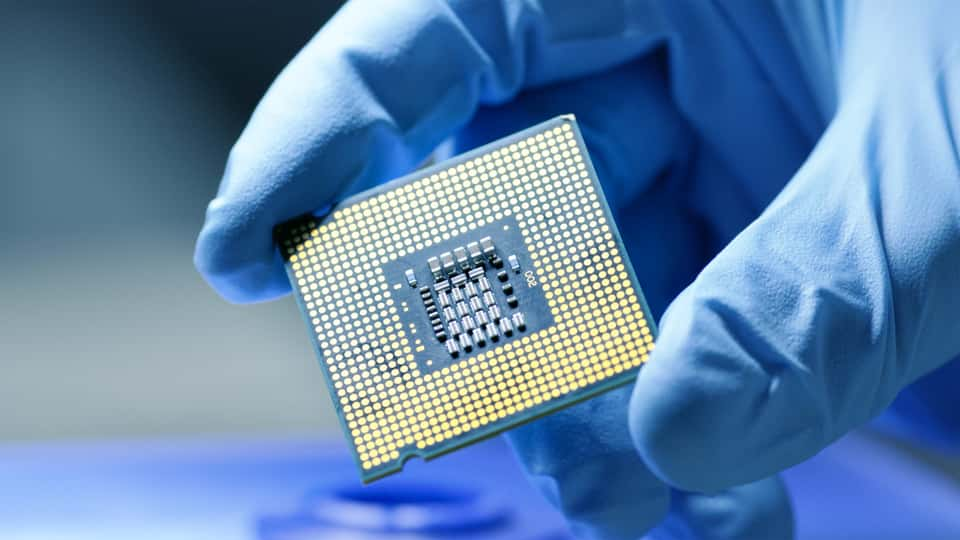NVIDIA Corporation (NVDA - Get Rating) in Santa Clara, Calif., is a visual computing company that operates worldwide under Graphics and Compute & Networking segments. In comparison, Micron Technology, Inc. (MU - Get Rating) in Boise, Idaho, operates as a designer, manufacturer, and seller of storage products globally through its Compute and Networking Business Unit; Mobile Business Unit; Storage Business Unit; and Embedded Business Unit.
The Semiconductor Industry Association (SIA) announced that global semiconductor industry sales in 2021 totaled $555.90 billion, representing a 26.2% increase from the prior year. In 2021, the industry shipped a record 1.15 trillion semiconductor units as chip companies geared up production to address the global chip shortage.
However, Ukraine supplies more than 90% of United States semiconductor neon, used in lasers for chipmaking, and Russia is the source of 35% of its palladium. Hence, the ongoing conflict could create supply strains. However, due to raw material stockpiling and diversified procurement, disruptions are expected to be limited. Furthermore, semiconductor sales are expected to grow 11% in 2022 to a record $680.60 billion. So, both NVDA and MU are well-known players in the industry and are expected to gain substantially from the industry’s growth. NVDA shares have gained 77.8% in price over the past year, while MU has declined 2.9% over the same period. However, MU’s shares have gained 20.1% over the past six months, while NVDA’s shares gained 7.7%. Over the past month, NVDA has declined marginally, while MU has gained 8%.
Click here to checkout our Semiconductor Industry Report for 2022
But which stock is a better buy now? Let’s find out.
Latest Developments
On February 16, Jaguar Land Rover announced the formation of a multi-year strategic partnership with NVDA to jointly develop and deliver next-generation automated driving systems and AI-enabled services and experiences for its customers. NVDA might stand to benefit from this partnership.
On January 11, MU announced that it began volume shipments of its 176-layer QLC NAND SSD and unveiled its 2400 PCIe Gen4 Client SSD. These improvements are expected to usher QLC SSDs into the client PC market. This could prove to be profitable for the company.
Recent Financial Results
MU’s revenue increased 33.2% year-over-year to $7.69 billion in its fiscal first quarter, ended December 2. Its non-GAAP net income rose 175.5% from the prior-year quarter to $2.47 billion, while non-GAAP EPS improved 176.9% from the same period in the prior year to $2.16.
For its fiscal fourth quarter, ended January 30, NVDA’s revenue increased 52.8% year-over-year to $7.64 billion. Its non-GAAP net income and non-GAAP net income per share improved 71.2% and 69.2%, respectively, from the same period in the prior year to $3.35 billion and $1.32.
Past and Expected Financial Performance
MU’s revenue has grown at a 17.9% CAGR over the past five years. Its total assets have grown at an 11.2% CAGR over the past three years. Analysts expect MU’s EPS to increase 16.5% in the quarter ending May 2022, 49% for the fiscal year 2022, and 33.1% for the fiscal year 2023. The Street expects its revenue to rise 16.7% for its fiscal year 2022 and 20.8% for its fiscal year 2023. MU’s EPS is expected to grow 23.8% per annum over the next five years.
In comparison, NVDA’s revenue has grown at a 31.3% CAGR over the past five years, while its total assets have grown at a 49.3% CAGR over the past three years. The consensus EPS estimate for the quarter ending April 2022, its fiscal year 2023, and fiscal year 2024 indicates increases of 41.8%, 26.4%, and 19.8%, respectively. Analysts expect its revenue to rise 43.3%, 28.9%, and 17.3% respectively over the same periods. NVDA’s EPS is projected to grow 30.2% per annum over the next five years.
Profitability
NVDA is more profitable in terms of its gross profit margin and net income margin of 64.93% and 36.23%, respectively, compared to MU’s 41.53% and 24.86%.
Furthermore, NVDA’s ROE, ROA, and ROTC of 44.83%, 17.2%, and 19.95%, respectively, compare with MU’s 17.16%, 9.34%, and 10.67%.
Thus, NVDA is more profitable here.
Valuation
In terms of forward non-GAAP PEG, MU is currently trading at 0.45x, which is 74.9% lower than that of NVDA, which is trading at 1.79x. And MU’s 2.99 forward EV/Sales multiple is 82.6% lower than NVDA’s 17.18 multiple. In terms of its forward EV/EBITDA, MU is trading at 5.30x, which is 86.6% lower than NVDA’s 39.61x.
Thus, MU is relatively affordable here.
POWR Ratings
MU has an overall A rating, which equates to Strong Buy in our proprietary POWR Rating system. In contrast, NVDA has an overall rating of C, which translates to Neutral. The POWR Ratings are calculated by considering 118 different factors, with each factor weighted to an optimal degree.
MU has a Value grade of B, which is consistent with its 8.32 forward EV/EBIT multiple, which is 51.3% lower than the 17.09 industry average. In comparison, NVDA has a D grade for Value. This is justified because its EV/EBIT of 35.98x is 110.5% higher than the industry average.
Both stocks have a B grade for Sentiment, in sync with the favorable analysts’ expectations about their revenue and EPS growth.
In the 97-stock Semiconductor & Wireless Chip industry, MU is ranked #5, while NVDA is ranked #61. The industry is rated B.
In addition to the POWR Rating grades we’ve stated above, one can see the additional Growth, Momentum, Quality, and Stability ratings for MU here and for NVDA, here.
Winner
The semiconductor industry has shown substantial growth, bolstered by strong demand over the past year. Furthermore, the industry is expected to keep growing with above-average growth in all major product categories. Given the industry’s solid growth prospect, both NVDA and MU should benefit. However, we think MU’s relatively cheaper valuation makes it a better bet than NVDA now.
Our research shows that odds of success increase when one invests in stocks with an Overall Rating of Strong Buy or Buy. View all the top-rated stocks in the Semiconductor & Wireless Chip industry here.
Click here to checkout our Semiconductor Industry Report for 2022
Want More Great Investing Ideas?
NVDA shares were trading at $233.65 per share on Tuesday afternoon, down $10.20 (-4.18%). Year-to-date, NVDA has declined -20.56%, versus a -9.47% rise in the benchmark S&P 500 index during the same period.
About the Author: Anushka Dutta

Anushka is an analyst whose interest in understanding the impact of broader economic changes on financial markets motivated her to pursue a career in investment research. More...
More Resources for the Stocks in this Article
| Ticker | POWR Rating | Industry Rank | Rank in Industry |
| NVDA | Get Rating | Get Rating | Get Rating |
| MU | Get Rating | Get Rating | Get Rating |






